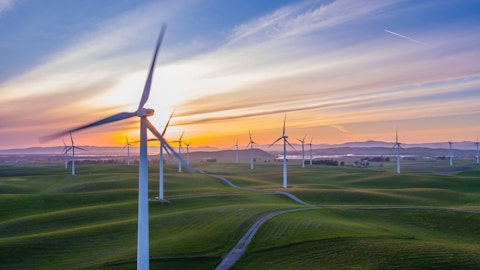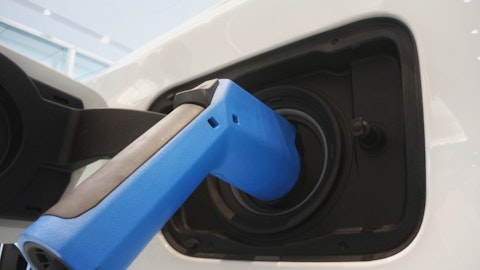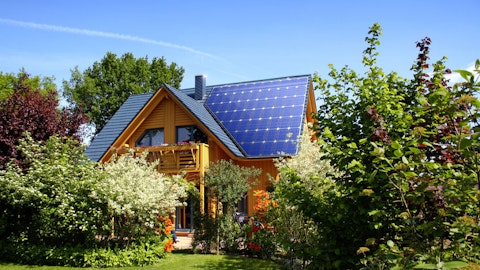Brookfield Renewable Partners L.P. (NYSE:BEP) Q4 2022 Earnings Call Transcript February 3, 2023
Operator: Good day and thank you for standing by. Welcome to the BEP, Brookfield Renewable’s Fourth Quarter Conference Call. I would now like to hand the conference over to your speaker today Connor Teskey, Chief Executive Officer. Please go ahead.
Connor Teskey: Thank you, operator. Good morning, everyone and thank you for joining us for our fourth quarter 2022 conference call. Before we begin, we would like to remind you that a copy of our news release, investor supplement and letter to unitholders can be found on our website. We also want to remind you that we may make forward-looking statements on this call. These statements are subject to known and unknown risks and our future results may differ materially. For more information, you are encouraged to review our regulatory filings available on SEDAR, EDGAR and on our website. On today’s call, we will provide a review of our 2022 performance and growth initiatives. Then Julian Thomas, who heads up strategic initiatives within our group, will discuss how we are harnessing our partnership with institutional capital to accelerate our growth.
And lastly, Wyatt will conclude the call by discussing our operating results and financial position. Following our remarks, we look forward to taking any of your questions. We have had another successful year, continuing our track record of double-digit average annual FFO growth for over a decade. We generated funds from operations of over $1 billion or $1.56 per unit, an 8% increase over last year as a result of the stability of our high-quality cash flows, organic growth in commercial initiatives and contributions from acquisitions. We agreed to deploy capital well ahead of our targets growing in every market we operate, while dramatically expanding our renewables operations and making our first transition investments. We also delivered record performance from our development activities with 19,000 megawatts of capacity either under construction or in advanced stages as well as we increased our global development pipeline to almost 110,000 megawatts.
We are now in the early days of more of these high returning development dollars beginning to flow through our income statement, a trend that we expect to continue as more and more of our projects reach commercialization. As it relates to capital deployment, 2022 has been our strongest year to-date. We closed or agreed to invest up to $12 billion or close to $3 billion net to Brookfield Renewable, which will be deployed over the next 5 years. This represents almost half of our growth target for that period. The investment environment for renewables remains highly compelling. Renewables low cost energy profile, combined with the themes of corporate clean energy demand, electrification and energy independence, continue to be key trends accelerating renewable deployment.
Our disciplined approach to investing and long history of owning and operating renewables enables us to capture some of the most attractive opportunities going forward. And as Wyatt and Julian will discuss later, we maintain a best-in-class balance sheet, robust levels of liquidity, and access to diverse and deep pools of capital, including our ability to invest alongside large scale institutional capital, which enables us to execute on sizable transactions that generate strong risk adjusted returns. During the year, we agreed to invest up to $4.6 billion or $1.4 billion net to Brookfield Renewable of capital into our renewable development initiatives through both organic growth within our existing business and by acquiring new complementary platforms that enhance our current offering.
This includes our investment in three large renewable development businesses in the United States: urban grid, standard solar and scope clean energy. These investments enhance our position in whatever our largest market, bringing our total size to 74,000 megawatts of operating in development capacity in the US. Since acquiring these businesses, we have worked quickly to integrate them into our overall U.S. platform and have begun executing on the business plans we set out. We are already seeing strong performance from these new investments. They are all benefiting from the Inflation Reduction Act in strong corporate demand, which is enabling us to accelerate the development pipelines and grow these businesses beyond our original underwriting expectations.
Turning to nuclear power, as many are aware, we formed a strategic partnership with Cameco to acquire Westinghouse, one of the world’s largest nuclear services businesses and a critical player in the energy transition. We are moving forward with obtaining the required approvals for this investment and are on track to close the transaction in the second half of 2023. The business is performing well and we are already seeing benefits of the investment beyond our underwriting as nuclear is increasingly recognized as a provider of clean dispatchable baseload power generation. As an example, the Polish government announced that it has selected Westinghouse’s AP1000 technology for the build-out of the first three of its planned large scale nuclear reactors.
This is the key step towards the country achieving its decarbonization targets and greater energy independence. We are also progressing our transition asset investments, including most recently, our investment in California Bioenergy, a leading California based developer, operator and owner of RNG assets, where we have the ability to invest up to $500 million or $100 million net to Brookfield Renewable in downside protected convertible structures that support the development of new agriculture renewable natural gas assets. This investment is another in the continuation of our strategy of entering into high growth transition asset classes that are complementary to our core renewables business. Similar to carbon capture and storage, recycling and renewable natural gas, we have invested through small upfront capital deployments with experienced partners through investment structures that provide us with downside protection, discretion over future investments, and significant potential upside returns on our capital.

Photo by Thomas Richter on Unsplash
As we enter 2023, our business has tremendous momentum. As a leading global clean energy company with deep access to capital, we are uniquely positioned to execute on the most attractive clean energy and decarbonization investment opportunities around the world. Given our strong financial and operating performance, robust liquidity and positive outlook for the business, we are pleased to announce a 5.5% increase to our distributions to $1.35 per unit on an annualized basis. This is the 12th consecutive year of at least 5% annual distribution growth since 2011, when Brookfield Renewable was publicly listed. With that, we will now turn it over to Julian to discuss the importance of our capital sources in supporting our growth.
Julian Thomas: Thank you, Connor and good morning everyone. We have said for many years that the strength of our balance sheet and our ability to invest alongside large scale institutional capital represents a significant competitive advantage. We have always prioritized capitalizing the business with a strong investment grade balance sheet, utilizing long duration non-recourse debt and maintaining high levels of liquidity. This allows us to maintain a low risk financial profile and focus on financial strength and flexibility so we can invest throughout the cycle. We believe this is critical to our long-term success as it contributes meaningfully to the compounding of our cash flows and the total returns delivered to our unitholders.
In addition to this approach is our structure of investing alongside Brookfield’s private funds, which provides access to scale, long-term institutional capital, enabling us to target sizable deals, where there is often limited competition. At Brookfield, we manage capital for more than 2,000 institutional clients that collectively have trillions of dollars of capital under management to invest. This means we have the ability to target multibillion dollar transactions, instead of smaller investments that are in many cases far more competitive. We believe this structure is often underappreciated by the market. However, we think it represents a very meaning meaningful competitive advantage for our business, particularly in this economic environment.
Combined with our platform capabilities, this means that on a recurring basis, we can generate strong risk-adjusted returns by executing some of the most attractive, large scale decarbonization opportunities. Investor appetite for energy transition remains very strong. We have significant institutional demand to invest alongside experienced owners, operators and investors like us. The success of Brookfield’s first transition fund demonstrates this. We raised $15 billion, establishing the world’s largest private fund dedicated to facilitating the global transition to a net-zero economy. The Fund features some of the largest commitments in Brookfield’s history, with around 30% coming from new clients, illustrating investor desire to allocate meaningful capital towards energy transition.
A key part of Brookfield’s private fund strategy is developing relationships with large pools of long-term private capital who seek the opportunity to invest alongside us both by investing in our private funds and also directly in our investments as co-investors. The program both enhances our access to capital and provides another source of liquidity. Our Westinghouse investment, given its size, is a great example of our co-investment program in practice. We have had strong interest from our LPs to co-invest with us in Westinghouse and the process is moving along well. Today, access to capital is limited for some market participants. So accessing this funding source represents an even more meaningful competitive advantage. Institutional capital supports our ability to invest in great businesses and achieve strong results that maximize long-term returns for our investors.
The scale of our transition fund and the institutional relationships and capital it brings is another meaningful step change in our funding strategy that we will continue to employ as we grow our business and seek large-scale attractive investment opportunities. With that, I’ll turn it over to Wyatt to discuss our operating results and financial position.
Wyatt Hartley: Thank you, Julian. As Connor mentioned in his earlier remarks, we had strong results in the quarter as our operations benefited from strong global power prices and continued growth both through development and acquisitions. We generated FFO of over $1 billion or $1.56 per unit, reflecting solid performance and an increase of 8% versus the same period last year. Our business is backed by high-quality cash flows in large part from our perpetual hydro portfolio, which has become an increasingly valuable source of clean, baseload power, as more intermittent renewables come online. With over 5,000 gigawatt hours of generation available for recontracting across our portfolio over the next 5 years and the positive pricing environment for our hydro portfolio, we have significant capacity across our fleet to execute on accretive contracts that we expect to contribute additional FFO and generate a low-cost funding source for our growth.
Our financial position remains excellent and our available liquidity is robust, providing significant flexibility to fund our growth. Julian already touched on the importance of our access to capital and maintaining a strong balance sheet. We are resilient to the rising interest rates globally, with over 90% of our borrowings being project level, fixed rate non-recourse debt, with an average remaining term of 12 years, no material near-term maturities and only 3% exposure to floating rate debt. Despite market volatility, our access to deep and varied pools of capital continues to be differentiated. We have approximately $3.7 billion of available liquidity, giving us significant financial flexibility during periods of capital scarcity. During the year, we secured approximately $10 billion of non-recourse financings across the business, resulting in approximately $1.2 billion in financing proceeds to Brookfield Renewable.
We are also accelerating our capital recycling activities, which are both in accretive funding lever and a critical part of our full cycle investment strategy. We continue to see a very constructive environment for selling de-risked appropriately sized mature renewable assets to lower cost of capital buyers and we are advancing numerous capital recycling opportunities in this regard. We have initiated several processes, where we have successfully completed our business plan and executed on our investment thesis. These assets could generate up to $4 billion in aggregate, approximately $1.5 billion net to Brookfield Renewable of proceeds when closed and provides significant incremental liquidity in the coming quarters. In closing, we remain focused on delivering 12% to 15% long-term total returns for our investors.
To do this, we will continue to be disciplined allocators of capital by leveraging our deep funding sources and operational capabilities to enhance value and derisk our business. On behalf of the Board and management, we thank all our unitholders and shareholders for the ongoing support. We are excited about Brookfield Renewable’s future and look forward to updating you on our progress throughout 2023. That concludes our formal remarks for today’s call. Thank you for joining us this morning. And with that, I will pass it back to our operator for questions.
See also 10 Hot Healthcare Stocks To Buy Now and 10 Hot Tech Stocks To Buy Now .
Q&A Session
Follow Brookfield Renewable Partners L.p. (NYSE:BEP)
Follow Brookfield Renewable Partners L.p. (NYSE:BEP)
Operator: Our first question comes from the line of Sean Stewart with TD Securities.
Sean Stewart: Thank you. Good morning. Couple of questions. With respect to the broader asset recycling plan that that you laid out, Wyatt, beyond the Mexican solar portfolio, can you give us any context on the regional or technology focus for that asset sale program? And further to that any guidance on returns you expect you will be able to crystallize through those initiatives?
Connor Teskey: Sure. Sean, it’s Connor. Perhaps I’ll take that. We probably don’t want to comment on any of the live sales processes that we have going. But we are certainly happy to provide some incremental color. The background to this is during the second half of 2022, we saw significant inbounds from potential buyers for a number of our businesses. And what we are finding is those inbounds are particularly coming on businesses that we feel we have largely de-risked and we have largely executed our initial investment thesis and our initial business plan and that’s when we like to sell assets when we have an interested buyer and we have completed the de-risking and value creation process that we initially set off to do. What I would say in terms of locations, it’s what we would probably say is the vast majority of capital recycling that we see the potential for in the next few quarters is largely in the Americas, both North and South America for us.
And then in terms of IRR, we are very we absolutely recognize that underlying rates have gone up, but we have not seen much if at all any widening in terms of target investor returns on a total IRR basis in the inbound price indications that we have seen. So we continue to monitor that, but we do still see a very, very constructive bid for de-risked high quality renewables assets and those are the types of things that we would look to sell as part of this program.
Sean Stewart: Thanks, Connor. That’s useful detail. Second question, in your supplemental information, the buildup of your advanced stage development pipeline for 2023, it looks like there is quite a bit added to your Asia platform at least compared to the guidance you gave a quarter ago. Can you give us any detail on what’s been added to that particular piece of the development platform?
Connor Teskey: Yes, certainly. So I will start and Wyatt if I miss anything, please don’t hesitate to jump in. There is two things in particular that have been added that jump to mind. One is in India, in the latter part of last year, we have pursued this strategy of building out renewable energy parks in India. And that is a somewhat unique strategy within India, where you buy large plots of lands that have strong grid connection and you can build out renewables over multiple phases and sell the power from those projects to multiple off-takes. We have done a number of those transactions in the latter part of the year and that would certainly be inflating that number. The other thing that I would highlight is our previously announced arrangement with BASF, where we are looking to build renewables for them in China that will be directly contracted to a new large chemical production facility that BASF is building in the region that they want to be supported by green power.



